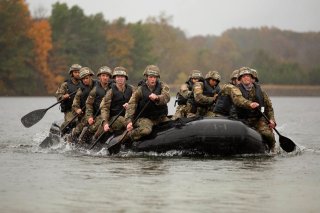History Provides Another Alternative to the All-Volunteer Force
It is time that serious observers and policymakers begin shifting the debate beyond the dual possibilities of either the AVF or a draft to meet realistic defense needs.
But an army bill was not dead. Congressional leaders—Representative Hay in the House and Senator George Chamberlain in the Senate—took the legislative lead in their respective chambers. While Hay preferred a smaller regular force and put more emphasis on increasing the National Guard’s numbers, satisfying southern states’ rights constituents and midwestern antipathy toward preparedness, Chamberlain’s bill in the Senate increased both the regular force and the National Guard. Two real-world crises helped drive a compromise bill that favored the Chamberlain proposal. The first was the attack on Columbus, New Mexico by Pancho Villa in March. Wilson responded by sending into Mexico an expedition in pursuit led by Brigadier General John J. Pershing. The second was the sinking of the French ship Sussex by a German submarine in late March, resulting in a war scare throughout April and early May as Wilson threatened to break relations with Germany.
The National Defense Act of 1916 was signed into law on June 3 and increased the regular army to 20,169 over five years. The National Guard grew in strength to 425,000 men because of this bill, but importantly the legislation put the militia under greater federal control for weapons, training, equipment, pay, and made it easier to federalize the force in an emergency. Wilson did just that by calling out the entirety of the National Guard to the U.S.-Mexican border on June 18, just days after signing the bill. The law also established the Reserve Officer Training Corps (ROTC) system and a more federalized army reserve. The National Defense Act, along with the Naval Appropriations Act and the various other preparedness legislations of 1916 represented a remarkable feat in the face of varying U.S. interests that attempted to place the United States on a more reasonable footing in case war came. By April 1917, less than a year after the enactment of these important bills, the United States was at war and expanding the military and defense machine much more than the preparedness debates of 1915-1916.
Conclusion
Bringing the discussion back to the original emphasis of this article, the AVF of today represents a highly capable and professionalized military, but it also is a system that is destined to become more and more strained over time. Rising personnel costs, a growing culture of entitlement as the gap between civilians and military service expands, a less representative military, and overuse of a force that is too powerful—these trends are debilitating to the long-term sustainability of the AVF.
It is time that serious observers and policymakers begin shifting the debate beyond the dual possibilities of either the AVF or a draft to meet realistic defense needs. The Continental Army plan considered in 1915-1916 is an example of the type of unique and visionary thinking that a dilemma like a complex and military manpower requires. While flawed, unworkable, and too much for the politicians and the public of 1915-1916 to accept (some of the failure is because of Secretary Garrison’s lack of detailed analysis and preparation), the Continental Army plan envisioned a greater reliance on reserve forces rather than a costly standing army. In theory, as similarly argued recently by Stephen Wertheim, the United States may be less likely to use its highly-capable, large-standing military force for unnecessary military adventures—and more likely to use it in the face of actual emergencies—if it were forced to rely on a large pool of reserves called up from towns and cities across the country.
The Continental Army plan failed to become law and it was not the right plan for 1915-1916 U.S. politics. But Congress and defense leadership must expand thinking about the future of the force beyond simply either conscription or the AVF. Unique and revolutionary efforts like that of the reserve-focused Continental Army plan are worthy discussions to find a path toward improving the sustainability of American defense and ensuring the future military’s proper operational use.
Alex Beckstrand is an officer in the Marine Corps Reserves, a Ph.D. Candidate in history at the University of Connecticut, an adjunct professor, and he works in the aerospace industry. All views are his own and do not represent the views of the United States Marine Corps or the Department of Defense.
Image: Reuters.

